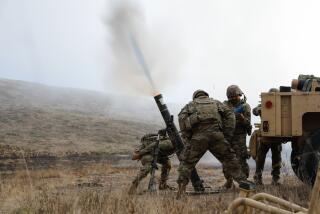Looking for a New Ship to Come In
- Share via
RIDGECREST, Calif. — In this remote High Desert city, the county fair slogan is “shake and bake.” It isn’t just the recurring earthquakes or the convection-oven temperatures that give the phrase its punch.
Ridgecrest residents are trembling and sweating these days, facing a future more independent from the naval base that has been the city’s meal ticket since post-World War II days. Like other Navy towns burned by a dwindling federal defense budget, Ridgecrest is in the throes of separation anxiety.
“If the base closes, even five years from now, we’re dead,” said Ray Arthur, executive director of the Ridgecrest Area Convention and Visitors Bureau. “Ridgecrest is struggling . . . because of that umbilical tie to the base.”
A suburban outpost cupped in a wind-swept valley of the Mojave Desert off U.S. 395, in the rain shadow of the Sierra Nevada, Ridgecrest is growing up and away from the paternal government agency that sired and reared it.
The Naval Air Weapons Station at nearby China Lake is a premier Department of Defense “research, test, development and evaluation” facility for air-to-air and air-to-surface weapons (read: things that go boom), but few Southern Californians know it exists.
Fifty years ago, the Navy nicknamed its desert hideaway “the secret city.” Lately, residents have been eager to let the cat out of the bag.
After a tenfold population leap in the span of 40 years, the once prospering bedroom community to the base is now in dire need of a financial transfusion. Reacting to government belt-tightening, the naval station has laid off a quarter of its work force since 1991, shutting about 2,000 people out of a livelihood.
According to Hal Bennett, a former naval station physicist and local entrepreneur, “Stores are moving away. The quality of life will go down. I don’t see the need for that to happen.”
The lifeline he dangles to a scrabbling citizenry is a rocket scientist’s dream.
Bennett bills his ambitious SELENE (Space Laser Energy) project, which has already received $500,000 in state funding, as “the gas station on the space information highway.”
The project would use laser-beaming technology to supply electrical power to orbiting communications and surveillance satellites that now rely on solar panels. SELENE aims to make satellite upkeep 10% to 12% cheaper.
*
Ridgecrest’s isolation makes it a prime locale for the space laser industry Bennett envisions. Laser beams more brilliant, and more damaging to the retina, than five suns are less likely to bump into stray birds and pilots on their way up. And the town boasts 260 cloud-free days per year, making for bright constellations and minimal atmospheric distortion for lasers to slice.
Bennett says the SELENE project could bring 300 to 500 jobs to Ridgecrest scientists, electricians and maintenance workers for starters. The base has given a cautious nod to Bennett’s request to use Navy land.
Bennett hopes SELENE and the Navy can eventually scratch each other’s backs, but the entrepreneur’s sights go beyond government contracting.
“SELENE can make Ridgecrest a focus for space-power beaming in the country and in the world,” he speculates. “It will provide communication for everybody in the world, no matter where they live.”
Ridgecrest hopes that Bennett’s project is more than a pipe dream. At best, if matching funds surface, it is five years from realization. Meanwhile, die-hard residents dig in their heels as retailers like JCPenney and Miller’s Outpost line up for the exits, blocks of empty houses and apartments stranded in their wake. Last fall, Thrifty Drug Stores left town.
Ironically, this slump is occurring just when the area has begun to make a modest name for itself as a film site. When Steven Spielberg’s location manager for “Jurassic Park” couldn’t afford the badlands of South Dakota, he lunched with Ridgecrest’s Arthur, who got him nearby Jawbone Canyon instead.
“Star Trek 5” was filmed near Ridgecrest, and the schlock ‘60s show “Lost in Space” shot its spaced-out exteriors at neighboring Trona Pinnacles.
Recently, townspeople fluttered when Cindy Crawford spent the night while filming a foreign car commercial. Sony immortalized Ridgecrest’s earthquake spate with a commercial for an unshakable CD player. The cast and crew of the recent release “Bulletproof” poured coins into local coffers while filming in the mountains nearby.
“Nevada” and Johnny Depp’s “The Brave” (which looks to be the town’s biggest cinematic cash cow yet) recently concluded filming.
Arthur is pleased with the Hollywood flurry’s therapeutic effect on the local economy, but is frank about its long-term benefit. “It’s like putting a Band-Aid on a bleeding artery,” he said.
Ridgecrest’s down-home feeling drew Arthur, a 40-ish former radio executive, and kept him in the desert despite buffeting winds and blast-furnace summer heat. He calls the hidden city a perfect place to raise his kids.
“But that asset presents a dichotomy,” he admits. “Young families need a career to come to. Unless and until we get the jobs. . . .” His gravelly voice trails off.
Whether the town collapses around it or blossoms, the Navy is in the desert for the duration. “I can’t believe they would let this jewel go away,” Arthur says of the base.
“We at the base have a real responsibility to be good neighbors,” says Rear Adm. Jack V. Chenevey, the ranking officer at China Lake. “We can play a limited role [in the city’s economic future], but we are limited by law as to what we can do to support any civilian organization.”
Chenevey says the base is set to lay off another 400 employees through “normal attrition” by 1999.
As visions of laser-powered “gas stations” and largess from Tinseltown dance through the heads of the city’s leaders, pondering the future runs rampant.
“It’s a crapshoot,” Arthur says.
More to Read
Sign up for Essential California
The most important California stories and recommendations in your inbox every morning.
You may occasionally receive promotional content from the Los Angeles Times.










